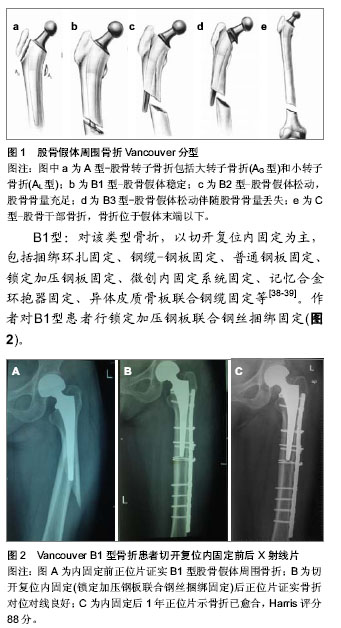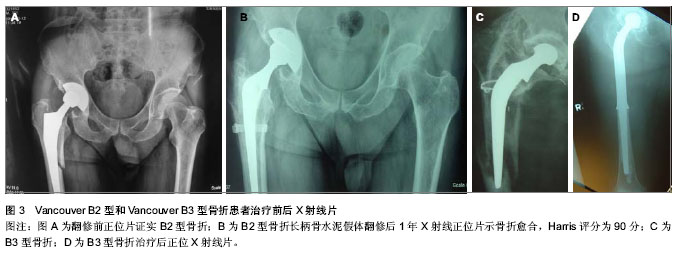| [1] Duwelius PJ, Schmidt AH, Kyle RF,et al. A prospective, modernized treatment protocol for periprosthetic femur fractures. Clin Orthop North Am. 2004;35(4):485-492.[2] Lindahl H. Epidemiology of periprosthetic femur fracture around a total hip arthroplasty. Injury. 2007;38(6): 651-654.[3] Lindahl H, Garellick G, Regner H, et al. Three hundred and twenty-one periprosthetic femoral fractures. J Bone Joint Surg Am. 2006;88(6): 1215-1222.[4] Masri BA, Meek RM, Duncan CP. Periprosthetic fractures evaluation and treatment. Clin Orthop Relat Res. 2004;420: 80-95.[5] Masri BA, Duncan CP, O’Brien PJ, et al. Principles of Treatment for Periprosthetic Femoral Shaft Fractures Around Well-fixed Total Hip Arthroplasty. J Am Acad Orthop Surg. 2009;17(11):677-688.[6] 张纪,周一新,周乙雄. 髋关节置换术中股骨假体周围骨折危险因素的分析[J].中华关节外科杂志:电子版,2010,4(4):488-493.[7] 陈炜平,王祥华.股骨假体周围骨折的危险因素[J].国际骨科学杂志,2008,29(1):16-18.[8] Franklin J. Malchau H. Risk factors for periprosthetic femoral fracture. Injury. 2007;38(6):655-660.[9] Lindahl H, Eisler T, Oden A, et al. Risk factors associated with the late periprosthetic femoral fracture. In: Lindahl H,editor. The periprosthetic femur fracture: a study from the Swedish National Hip Arthroplasty Register. Goteberg:Goteberg University, 2006:16-19.[10] 张占岭,陈长安.全髋关节置换术后并发假体周围骨折相关因素分析[J].现代预防医学,2012,39(15):3961-3963.[11] Lindahl H, Malchau H, Herberts P, et al. Periprosthetic femoral fractures: classifi¬cation and demographics of 1049 periprosthetic femoral fractures from the Swedish National Hip Arthroplasty Rosier. J Arthroplasty. 2005;20(7):857-865.[12] Beals RK, Tower SS. Periprosthetic fractures of the femur. An analysis of 93 fractures.Clin Othop. 1996;327:238-246.[13] Cooke PH, Newman JH. Fractures of the femur in relation to cemented hip prostheses. J Bone Joint Surg Br. 1988;70(3): 386-389.[14] 熊高鑫,黄彰,江华.人工髋关节置换术中股骨假体周围骨折影响因素及相关分析[J].实用医学杂志,2012,28(9):1504-1506.[15] Berry DJ. Epidemiology: hip and knee. Clin Orthop North Am. 1999;30(2):183-189.[16] Tsiridis E, Haddad FS, Gie GA. The management of periprosthelic femoral fractures around hip replacements. Injury. 2003;34(2):95-105.[17] Lewallen DG, Berry DJ. Periprosthetic fracture of the femur after total hip arthroplasty: treatment and results to date. Instr Course Lect. 1998;47:243-249.[18] 唐广满,孔建中.全髋置换术后股骨侧假体周围骨折的手术治疗进展[J].创伤外科杂志,2011,13(4):364-367.[19] 周印.人工髋关节置换术中发生假体周围骨折的原因及防治措施[J].中国医药指南,2012,10(36):134-135.[20] 黄峰,陈允震.股骨粗隆间骨折的治疗进展[J].中国骨与关节损伤杂志,2009,24(6):570-572.[21] 万仑,刘仲前,吕波.人工髋关节置换术并发股骨假体周围骨折的治疗[J].四川医学,2009,30(8):259-1260.[22] Harris B, Owen JR, Wayne JS, et al. Does femoral component loosening predispose to femoral fracture? Clin Orthop. 2010;468(2):497-503.[23] 郑东.人工髋关节置换后股骨假体周围骨折[J].中国组织工程研究,2012,16(30):5662-5669.[24] Ninan TM, Costa ML, Krikler SJ. Classification of femoral periprosthetic fractures.Injury. 2007;38(6):661-668.[25] Brady OH, Masri BA, Duncan CP, et al. Classification of the hip. Clin Orthop North Am. 1999;30(2):215-220.[26] Naqvi GA, Baig SA, Awan N, et al. Interobserver and intraobserver reliability and validity of the Vancouver classification system of periprosthetic femoral fractures after hip arthroplasty.J Arthroplasty. 2012;27(6):1047-1050.[27] Brady OH, Garbuz DS, Masri BA, et al. The reliability and validity of the Vancouver classification of femoral fractures after hip replacement. J Arthroplasty. 2000;15(1):59-62 .[28] 赵建宁,周利武,郭亭, 等.股骨假体周围骨折的治疗[J].中国创伤杂志,2004,20(11):660-663.[29] 杨波,吴杰,喻飞,等.人工髋关节置换术后股骨假体周围骨折的治疗体会[J].中国骨与关节外科,2011,4(2):110-113. [30] Berry DJ. Management of periprosthetic fractures: the hip. J Arthro plasty. 2002;17(4):11-13.[31] Duncan CP,Masri BA. The role of antibiotic - loaded cement in the treatment of an infection after a hip replacement. Instr Course Lect. 1995;44:305-313.[32] 丛锐军,刘伟,李晓华, 等.全髋置换术后股骨假体周围骨折的治疗[J].中国骨与关节外科,2009,2(6):435-437.[33] Pritchett JW. Fractures of the greater trochanter after hip replacement. Clin Orthop. 2001;390:221 -226.[34] 张炅,王毅,杨庆铭,等.股骨假体周围骨折手术治疗策略[J]. 中华关节外科杂志:电子版,2009,3(5):558-564.[35] Mont MA,Maar DC. Fractures of the ipsilateral femur after hip ar¬throplasty. A statistic alanalysis of outeome based on 487 patients. J Arthroplasty. 1994;9(5):511 -519.[36] 李展春,臧危平,程光齐,等. Vancouver B型股骨假体周围骨折的手术治疗分析[J].实用骨科杂志,2011,17(6):516-518.[37] 司刚,蒋建农,王勇,等. Vancouver B型股骨假体周围骨折的治疗[J].中国骨与关节损伤杂志,2010,25(12):1106-1108.[38] 汤冀强. Vancouver B1型股骨假体周围骨折的手术治疗[J].实用骨科杂志,2011,17(12):1111-1113.[39] 胡忠伟,何伟涛,项叶丹,等. AO锁定钢板结合线缆系统微创内固定治疗Vancouver B1型股骨假体周围骨折[J]. 中国骨与关节损伤杂志,2013,28(2):150-151.[40] 丛宇,赵建宁.全髋关节置换术中假体周围骨折的研究进展[J]. 中国骨伤,2011,24(2):178-181.[41] Springer BD,Berry DJ,Lewallen DG, et al. Treatment of periprosthetic femoral fractures following total hip arthroplasty with femoral component revision. J Bone Joint Surg Am. 2003; 85(11):2156 -2162.[42] Corten K, Macdonald SJ, McCalden RW, et al. Results of cemented femoral revisions for periprosthetic femoral fractures in the elderly. J Arthroplasty. 2012;27(2):220-225 .[43] 胡金艮,林向进.全髓关节置换术后股骨假体周围骨折治疗进展[J].国际骨科学杂志,2010,31(4):227 -228.[44] Howell JR, Masri BA, Garbuz DS, et al. Cable plate and onlay allgraft in periprosthetic femoral fractures after hip replacement:laboratory and clinical observation. Instr Course Letc. 2004;53:99-110.[45] Maury AC,Pressman A,Cayen B, et al. Proximal femoral allogrart treatment of Vancouver type- B3 periprosthetic femoral fracture after total arthroplasty. J Bone Jiont Surg Am. 2006;88(5):953-958.[46] Young SW,Pandit S, Munro JT,et al. Periprosthetic femoral fracture after total arthroplasty. ANZJ Surg. 2007;77(6): 424-428.[47] Mukundan C, Rayan F, Kheir E, et al. Management of late periprosthetic femur fractures: a retrospective cohort of 72 patients. Orthop Int. 2010;34(4):485-489.[48] Bryant GK, Morshed S, Agel J, et al. Isolated locked compression plating for Vancouver Type B1 periprosthetic femoral fractures. Injury. 2009,40(11):1180-1186.[49] Agarwal S, Andrews CM, Bakeer GM. Outcome Following Stabilization of Type B1 Periprosthetic Femoral Fractures. J Arthroplasty. 2005;20(1):118-121.[50] Rayan F, Konan S, Haddad FS.Uncemented revision hip arthroplasty in B2 and B3 periprosthetic femoral fractures-A prospective analysis. Hip Int. 2010;20(1):38-42. |


